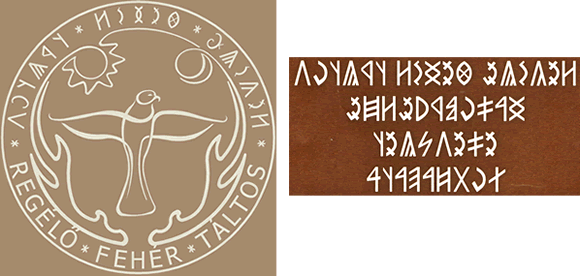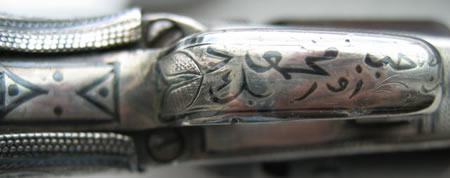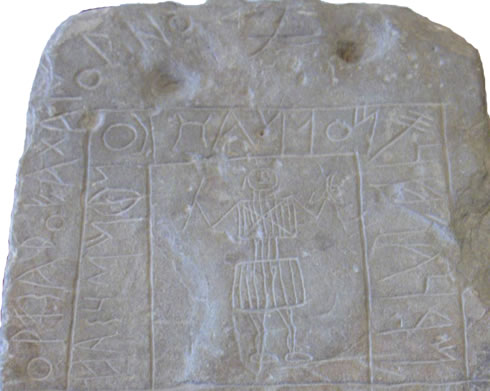This medallion belonged to Kevin Silver’s father and was believed to be his grandfather’s originally. Kevin has been told is “probably” a protection device that his grandfather wore to protect himself from harm and evil spirits. His grandfather was an Orthodox Jew from Russia who was very religious.
Kevin has tried to match the letter to the Hebrew, Aramaic, Greek, Ancient Greek, Russian, & Ancient Russian alphabets without success. Can you help?

I’ve decided to put puzzles on this blog to make it possible for you leave comments rather than having to send them to me. I don’t know why I didn’t think of this before.
Solution from Aharon Shmuel
The language is Hebrew written in the Paleo-Hebrew/Phoenician alphabet (abjad). The script is taken from the style used on coins minted during the Jewish revolts against Rome; indeed, this seems to be a replica of a coin from that period.
The text reads שנת אחת לגאלת ישראל; SHNAT ACHAT LEGE’ULAT YISRAEL; year one of Israel’s redemption. This phrase was used on coins minted during the revolts. In fact, Israel has issued stamps featuring ancient coins with this exact phrase on them: here and here.
One interesting feature here is the backwards letter Gimmel (the 8th letter, reading from right to left). I’ve been scouring the internet looking for an example of coins from this period with a backward Gimmel, but each one I’ve found has been facing forward. This, along with the owners comments, leads me to believe that this replica was made by a reader/writer of the Cyrillic alphabet who mixed up the Gimmel with the corresponding letter Ge – after all, what is a Cyrillic Ge if not a backward Gimmel.
Also, the Alephs are inconsistent (4th, 9th & 15th letters), and the Nun (2nd letter) looks more like a Mem but that could just be the picture quality.
As a side note, the current 1 and 10 New Israeli Shekel coins make use of Paleo-Hebrew; the ₪10 has a similar phrase, לגאלת ציון; LEGE’ULAT TZION; for the redemption of Zion.
All in all, a very cool coin to have – I’m jealous. As far as protection from spirits etc., could well have been intended for that. I’d wear it if I had it. -Aharon



